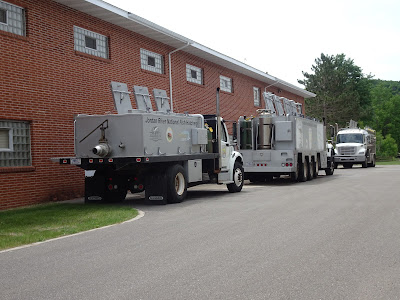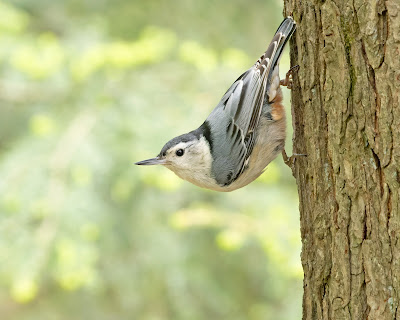Michigan tourism materials refer to The Sunrise Coast and the Sunset Coast to differentiate the coast of Lake Huron (The Sunrise Coast) from Lake Michigan (The Sunset Coast). Today we decided to explore the Lake Huron coast, so we headed north almost to the Mackinac Bridge, and then turned east.
Our first stop wasn't on the coast, but an area named Dingman Marsh. This area was made up of quiet rural roads through a wonderful natural marshy area. There was no traffic on the roads, allowing us to drive along slowly until we heard or saw birds, and then jump out to view and photograph them. In particularly good spots we would walk a couple of hundred yards up the road, and then back to the car. This is one of our favorite types of birding, as you can cover quite a bit of ground but still enjoy the solitude of nature.
We got excellent looks at several varieties of warblers. Most common were Chestnut-sided Warblers, who really like the short Alder trees that grow in the marsh.
Chestnut-sided Warbler
Less flashy but still a nice bird was a Northern Waterthrush that was singing, but very difficult to locate in the trees. Eagle-eye Teri picked it out and we finally got to see it well.
Northern Waterthrush
There was a large pond that we accessed by following a wooded trail, and we found a few Common Loons there.
We'd been hearing Common Loons in different places during our trip (one of the classic bird sounds of movies) but hadn't seen any yet. Unfortunately getting a well exposed picture on this beautiful black and white bird on a pond in bright sunlight proved difficult!
Common Loon
From Dingman Marsh we drove the short distance to Gordan Turner Park, which is right on Lake Huron. They also have a marshy area and a boardwalk and we spent a bit of time enjoying the views of Lake Huron and finding more birds.
We found more baby birds on the marsh and in the lake as well.
Canada Geese with goslings - Pretty close to Canada!
Mute Swans with cygnets
Yesterday we posted a picture of a Trumpeter Swan, which is a native species. Mute Swans, on the other hand, were introduced from Europe and are the subject of much controversy. Many people like to see them and are in favor of leaving them alone, but most wildlife agencies recognize them as an invasive species that competes with native swans. So there are efforts to control and/or eradicate Mute Swans from many areas of the North America. Easier said than done!!
One of the reasons that the forests of the northern US and Canada are such popular breeding grounds for migratory birds is the almost limitless supply of insects in spring and summer. We were prepared for Blackflies and Mosquitos and whatever we came across, but up to this point hadn't really been bothered by many insects. That changed here, and there was an enormous hatch of midges, which thankfully don't bite but love to get into your eyes, ears, hair (well, Teri's hair anyway...) and are just super annoying. Here is a picture I took of midges swarming around a tree.
Midges
The back of Mark's shirt after
we got out of the midges swarm.
From here we headed to Cheboygan State Park, just on the other side of the city of Cheboygan.
My father was born and raised in Cheboygan, Michigan and it was fun to finally visit the area, though it has changed greatly since his boyhood. Many of the Michigan State Parks were surprisingly small, with little infrastructure and in many cases no staff at all. I think that in this area they serve primarily to provide beach access to Lake Huron, which has beautiful tan sandy beaches.
We didn't see many birds in this park, but did spot a few sandpipers out on the sandy beach.
Semipalmated Sandpiper
Spotted Sandpiper
There are sandy dunes just up from the beach, and most of the dunes have some sort of grass growing on them. In a misguided attempt to take a shortcut, we decided to walk up through the dunes. It turns our that every tuft of grass was covered by midges, and as soon as we walked in there we were swarmed. We finally worked our way back out to the beach, but I think that we both swallowed a few bugs!
We got back to the car and continued our clockwise route along Sunrise Coast.
Next stop was Thompson's Harbor State Park, another practically deserted state park with a couple of bathrooms and a trailhead or two. We never saw another soul in the park, visitor or staff.
By now it was afternoon and the birds were quieting down, but we did enjoy a Brown Thrasher singing loudly from a treetop. They are in the same family as Mockingbirds, and while they aren't quite as talented, they still sing very well.
Brown Thrasher
Our final stop before leaving the coast and turning for home was Besser Natural Area.
Not a state park, but still primarily an access point to the beach. There was a nice wooded trail on the site, and we enjoyed a walk in the woods.
There was a small area of huge Eastern White Pines that had never been logged, and the remains of an old homestead, Our final bird of the tour was a male American Redstart, it his Halloween colors of orange and black. Way up in a tree...
American Redstart male
It had been a long day by the time we returned to our Cozy Cabin, but we were happy to have experienced much of the Sunrise Coast.
Next time: This is what could have been!






















%20-%20Fisherman's%20Island%20SP%2006-05-2022.jpg)

















































